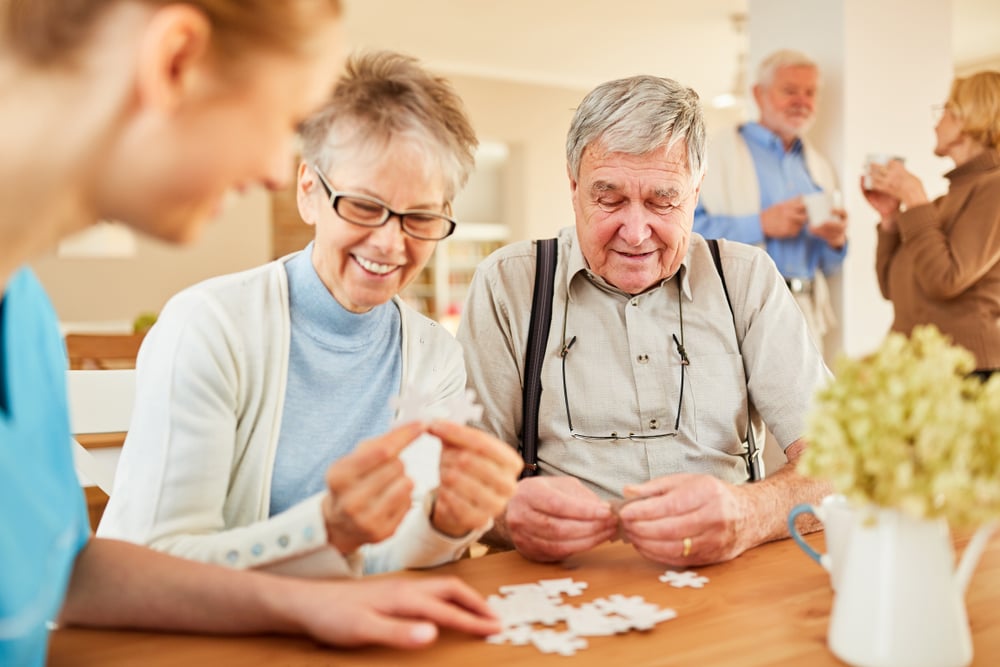It can be difficult to see a loved one change and lose their connection to you as a result of Alzheimer’s disease or other dementias. Finding ways to relate can be powerful for you and the person experiencing cognitive decline.
One method that can help make the link is sensory stimulation therapy, which is the practice of using everyday sounds, foods, objects and other items to awaken the senses and elicit a positive response or feeling. This form of therapy has the potential to help seniors express themselves and may even spark pleasant memories and emotions. Sensory stimulation can involve objects that are easy to find, such as flowers, sand, or old books—making it an accessible therapy that you can undertake on your own.
A closer look at Alzheimer’s disease
Dementia is a general term for memory loss and other cognitive abilities serious enough to interfere with daily life. Alzheimer’s disease is a progressive brain disease characterized by changes in the brain that result in loss of neurons and their connections, where dementia symptoms gradually worsen over a number of years. Approximately 60-80% of dementia cases can be attributed to Alzheimer’s.

In its early stages, memory loss is mild, but with late-stage Alzheimer’s, individuals lose the ability to remember, think, carry on a conversation, respond to their environment and live independently.
While there is no cure as of yet, treatment for symptoms is available and research continues. Current Alzheimer’s treatments can temporarily slow the worsening of dementia symptoms and improve quality of life for those with Alzheimer’s and their caregivers.
Causes
While the exact causes of Alzheimer’s in most people remain unknown, factors that can influence a person’s predilection to develop the disease include genetic, health, environmental, and lifestyle aspects.
The greatest known risk factor for Alzheimer’s is increasing age, with the majority of people with Alzheimer’s being 65 and older. The number of people with Alzheimer’s disease doubles about every five years beyond age 65. About one-third of all people age 85 and older may have Alzheimer’s.
Having a family history of the disease does not mean for sure that you’ll have it, too. But it may mean you are more likely to develop it.

Learn more about what causes Alzheimer’s disease
Top ten Alzheimer’s signs and symptoms
- Memory loss – A person begins to forget more often and is unable to recall the information later.
- Difficulty performing familiar tasks – Individuals may lose track of the steps involved in preparing a meal, placing a telephone call, or playing a game.
- Problems with language – People with Alzheimer’s disease often forget simple words or substitute unusual words, making their speech or writing hard to understand.
- Disorientation to time and place – People with Alzheimer’s can become lost in their own neighborhood, forget where they are and how they got there, and not know how to get home.
- Poor or decreased judgment – Those with Alzheimer’s may dress inappropriately, or show poor judgment, like giving away large sums of money to telemarketers.
- Problems with abstract thinking – Someone with Alzheimer’s disease may have unusual difficulty performing complex mental tasks, like forgetting what numbers are for and how they should be used.
- Misplacing things – A person with Alzheimer’s may put things in unusual places: an iron in the freezer or a wristwatch in the sugar bowl.
- Change in mood or behavior – Someone with Alzheimer’s disease may show rapid mood swings for no apparent reason.
- Changes in personality – The personalities of people with dementia can change dramatically. They may become extremely confused, suspicious, fearful, or dependent on a family member.
- Loss of initiative – A person with Alzheimer’s disease may become very passive, sitting in front of the TV for hours, sleeping more than usual, or not wanting to do usual activities.
Source: Top 10 Alzheimer’s Signs & Symptoms from The Fisher Center for Alzheimer’s Research
What is sensory stimulation therapy?
Sensory stimulation is often used to help seniors with Alzheimer’s or dementia because it can help them stay in the moment and interact with their current surroundings. Studies have shown that when done on a regular basis, sensory stimulation can be very helpful in treating memory issues. By offering different ways to communicate and engaging all five senses, seniors can see some improvement in daily functioning and cognitive symptoms.
For seniors with Alzheimer’s who have lost their ability to connect with the world around them, using everyday objects to stimulate senses can trigger positive thoughts, memories, or feelings that would otherwise be buried below the surface.
Activities involved in sensory stimulation are often linked to interests the person had prior to dementia and can help build a connection to everyday life. This sensory stimulation can be used strategically to arouse one or more of the five senses (hearing, sight, smell, taste, and touch), to evoke pleasant feelings.
How sensory stimulation activities help
Stimulating the senses of a person with dementia may lead to positive outcomes including helping them:
- Relax and feel safe.
- Increase levels of concentration and cognitive function.
- Feel content with the opportunity to recall past experiences and happy memories.
- Improve mood, self-esteem, and overall well-being.
- Inspire more participation in social activities and interactions with friends and family.
Even if you don’t notice results right away, incorporating sensory stimulation into the daily routine may help the person relive memories or communicate more effectively.
Sensory activities for dementia patients
You don’t have to be a therapist to use sensory stimulation with your senior loved one. Look around your home—most objects supply us with sensory input. Those family photos represent visual memories and expressions of happiness. They can elicit positive memories for people with dementia, bringing them comfort and ease. That pile of old books has the scent of antiquity and a weight and paper delicacy that trigger our sense of touch.
Activities stirring their systems
According to the Alzheimer’s Association, sensory stimulation activities might include:
- Bringing in objects the senior does not normally have around, such as sand, seashells, or other items
- Giving a hand massage
- Taking a short walk in a familiar location
- Talking or reading aloud
- Providing a change of scenery by taking the senior outdoors
- Brushing their hair, trimming their nails, or going all out with a full spa treatment
You make also want to:
- Create a memory box. Find a small shoebox and fill it with sentimental items. Include family photos, jewelry, and other items that would make your loved one smile if they saw it or touched it. Anything you can do to spark a memory or stimulate the senses could have a positive impact.
- Tap into meaningful experiences. Make an effort to connect the sensory stimulation exercises with the person’s interests, past or present. If the individual used to enjoy cooking, it may be fun to play a “guess the scent” game and have them smell containers filled with cinnamon, nutmeg, basil, and other familiar spices. If you’re looking for more general activities to be incorporated into the routine, try drawing a warm bath with scented bubbles or playing music that the person enjoys.
When a loved one is living with Alzheimer’s disease or other dementias, it can be a challenge for them to connect with you and with their surroundings. Sensory stimulation can help you relate to each other and enjoy quality time together.
SALMON Health and Retirement is skilled at creating the fullest lives possible for those with Alzheimer’s.




